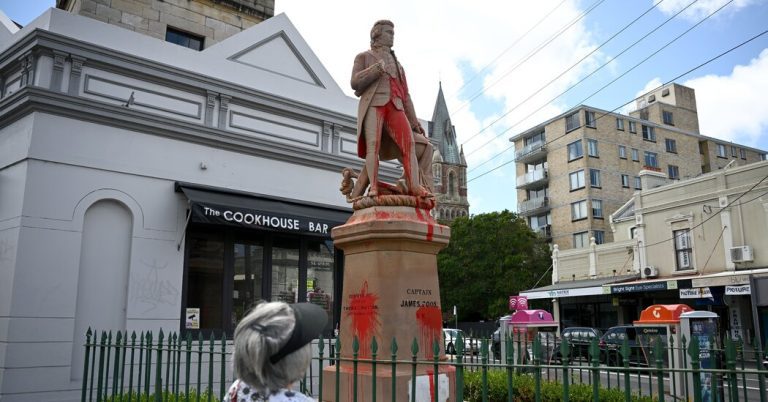Some Australians were in no mood to celebrate the country’s National Day on Sunday because they had long seen it as a reminder of colonial oppression. Some protesters took this antipathy a step further – vandalizing statues of British settlers and an English king.
The damage done in Sydney, Melbourne and Canberra was a new sign that Australia Day, which commemorates when a British fleet arrived in Sydney Harbor to start a penal colony in the late 18th century, remains divisive.
Even as some Australians mark the holiday with barbecues and pool parties, critics note it set in motion centuries of indigenous oppression. Some prefer to call it invasion day or survival day and make their displeasure clear through protests or other actions.
In Sydney this week, a statue of Captain James Cook, who claimed part of the Australian continent for the British crown in 1770, was found red. His hand and nose were also cut off. The statue had been restored after a similar attack last year.
In Melbourne, a monument to John Batman, an explorer who settled the city on Aboriginal-occupied land, was toppled and destroyed early Saturday. Protesters in Melbourne also spray-painted the words “land back” on a memorial to Australian soldiers who died fighting in the First World War.
And on Sunday in Canberra, the capital, there was graffiti on a statue of King George II. “The Colony is Falling,” someone had written on its base in red.
Australian officials condemned the vandalism.
“We should find it in our hearts and minds to respect differences of opinion, but not let it turn ugly,” said Jacinta Allan, the Victorian premier, according to a report by television station 9News.
Police spokesmen in the states of Victoria and New South Wales said on Sunday afternoon that there had been no arrests or charges in connection with the vandalism in Sydney and Melbourne. Police in Canberra did not immediately respond to an inquiry.
People have protested Australia Day for decades. Recent protests have been fueled by the Global Black Lives Matter movement, in which people in the United States, Britain and elsewhere toppled statues they saw as symbols of racism and oppression.
Last year in Melbourne, a statue of Captain Cook was dismembered and a monument to King George II was decapitated.
Many Australian officials are keenly aware of their country’s racist colonial past and are not afraid to say so publicly. In one example, the City of Melbourne website has a “truth” section that talks about developing a “shared understanding of the effects of colonization and dispossession on Aboriginal peoples”.
But simply acknowledging historical wrongs is not enough for some indigenous activists. This was clear when King Charles III visited Australia last year.
“You are not our king,” a voice boomed shortly after Charles, who retains the ceremonial title of head of state in the former British colony, finished addressing parliament. “Give us our land back. Give us what you stole from us. “
The voice belonged to Lidia Thorpe, a senior senator and Aboriginal rights activist. As security guards rushed her from the chamber, she accused the British colonists of genocide and called for Britain to make a treaty with the Australian population.
The king watched indifferently from the stage.




